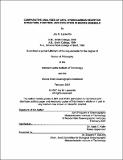Comparative analyses of aryl hydrocarbon receptor structure, function, and evolution in marine mammals
Author(s)
Lapseritis, Joy M
DownloadFull printable version (8.584Mb)
Other Contributors
Woods Hole Oceanographic Institution.
Advisor
Mark E. Hahn.
Terms of use
Metadata
Show full item recordAbstract
Marine mammals possess high body burdens of persistent organic pollutants, including PCBs and dioxin-like compounds (DLC). Chronic environmental or dietary exposure to these chemicals can disrupt the function of reproductive and immune systems, as well as cause developmental defects in laboratory animals. The aryl hydrocarbon receptor (AHR) is a ligand-activated transcription factor, mediating the expression of a suite of genes in response to exposure to DLC and structurally related chemicals. Species-specific differences in AHR structure can affect an organism's susceptibility to the effects of DLC. The structures and functions of several cetacean AHRs were investigated using in vitro molecular cloning and biochemical techniques. Using a novel combination of remote biopsy and molecular cloning methods, RNA was extracted from small integument samples from living North Atlantic right whales to identify the cDNA sequence for AHR and other genes of physiological importance. Biopsy-derived RNA was found to be of higher quality than RNA extracted from stranded cetaceans, and proved a good source for identifying cDNA sequences for expressed genes. (cont.) The molecular sequences, binding constants, and transcriptional activities for North Atlantic right whale and humpback whale AHRs cDNAs were determined using in vitro and cell culture methods. Whale AHRs are capable of specifically binding dioxin and initiating transcription of reporter genes. The properties of these AHRs were compared with those from other mammalian species, including human, mouse, hamster, and guinea pig, and other novel marine mammal AHRs, using biochemical, phylogenetic, and homology modeling analyses. The relative binding affinities for some marine mammal AHRs fall between those for the high-affinity mouse AHRb-1 and the lower affinity human AHR. Species-specific variability in two regions of the AHR ligand binding domain were identified as having the greatest potential impact on AHR tertiary structure, yet does not sufficiently explain differences observed in ligand binding assays. Additional studies are necessary to link exposure to environmental contaminants with potential reproductive effects in marine mammals, especially via interactions with steroid hormone receptor pathways.
Description
Thesis (Ph. D.)--Joint Program in Oceanography (Massachusetts Institute of Technology, Dept. of Biology; and the Woods Hole Oceanographic Institution), 2007. Includes bibliographical references.
Date issued
2007Department
Joint Program in Oceanography; Woods Hole Oceanographic Institution; Massachusetts Institute of Technology. Department of BiologyPublisher
Massachusetts Institute of Technology
Keywords
Joint Program in Oceanography., Biology., Woods Hole Oceanographic Institution.